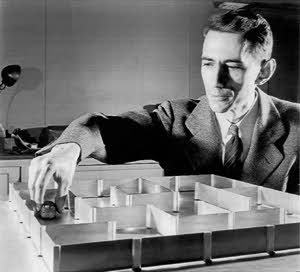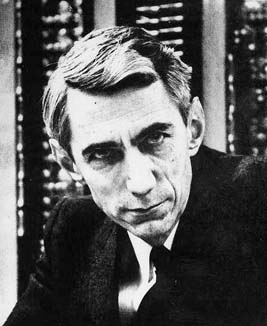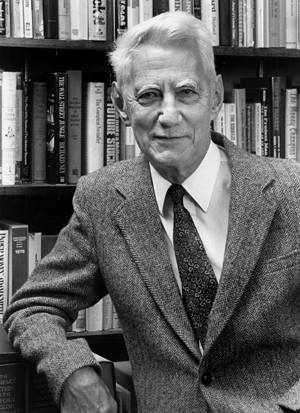| Vahid GarousiGarousiVahid Vahid |
a CSIT Home
> History of Information Theory
Claude Shannon
1916-2001
 Look at a compact disc
under a microscope and you will see music
represented as a sequence of pits, or in
mathematical terms, as a sequence of 0's
and 1's, commonly referred to as bits.
The foundation of our Information Age is
this transformation of speech, audio,
images and video into digital content,
and the man who started the digital
revolution was Claude Shannon, who died
February 24, at the age of 84, after a
long struggle with Alzheimer's disease. Look at a compact disc
under a microscope and you will see music
represented as a sequence of pits, or in
mathematical terms, as a sequence of 0's
and 1's, commonly referred to as bits.
The foundation of our Information Age is
this transformation of speech, audio,
images and video into digital content,
and the man who started the digital
revolution was Claude Shannon, who died
February 24, at the age of 84, after a
long struggle with Alzheimer's disease.
Shannon arrived at the revolutionary idea
of digital representation by sampling the
information source at an appropriate
rate, and converting the samples to a bit
stream. He characterized the source by a
single number, the entropy, adapting a
term from statistical mechanics, to
quantify the information content of the
source. For English language text,
Shannon viewed entropy as a statistical
parameter that measured how much
information is produced on the average by
each letter. He also created coding
theory, by introducing redundancy into
the digital representation to protect
against corruption. If today you take a
compact disc in one hand, take a pair of
scissors in the other hand, and score the
disc along a radius from the center to
the edge, then you will find that the
disc still plays as if new.
 Before Shannon,
it was commonly believed that the only
way of achieving arbitrarily small
probability of error in a communication
channel was to reduce the transmission
rate to zero. All this changed in 1948
with the publication of A Mathematical
Theory of Communication, where Shannon
characterized a channel by a single
parameter; the channel capacity, and
showed that it was possible to transmit
information at any rate below capacity
with an arbitrarily small probability of
error. His method of proof was to show
the existence of a single good code by
averaging over all possible codes. His
paper established fundamental limits on
the efficiency of communication over
noisy channels, and presented the
challenge of finding families of codes
that achieve capacity. The method of
random coding does not produce an
explicit example of a good code, and in
fact it has taken fifty years for coding
theorists to discover codes that come
close to these fundamental limits on
telephone line channels. Before Shannon,
it was commonly believed that the only
way of achieving arbitrarily small
probability of error in a communication
channel was to reduce the transmission
rate to zero. All this changed in 1948
with the publication of A Mathematical
Theory of Communication, where Shannon
characterized a channel by a single
parameter; the channel capacity, and
showed that it was possible to transmit
information at any rate below capacity
with an arbitrarily small probability of
error. His method of proof was to show
the existence of a single good code by
averaging over all possible codes. His
paper established fundamental limits on
the efficiency of communication over
noisy channels, and presented the
challenge of finding families of codes
that achieve capacity. The method of
random coding does not produce an
explicit example of a good code, and in
fact it has taken fifty years for coding
theorists to discover codes that come
close to these fundamental limits on
telephone line channels.
The importance of Shannon’s work was
recognized immediately. According to a
1953 issue of Fortune Magazine: "It
may be no  exaggeration to say that
man's progress in peace, and security in
war, depend more on fruitful applications
of information theory than on physical
demonstrations, either in bombs or in
power plants, that Einstein's famous
equation works". In fact his work
has become more important over time with
the advent of deep space communication,
wireless phones, high speed data
networks, the Internet, and products like
compact disc players, hard drives, and
high speed modems that make essential use
of coding and data compression to improve
speed and reliability. exaggeration to say that
man's progress in peace, and security in
war, depend more on fruitful applications
of information theory than on physical
demonstrations, either in bombs or in
power plants, that Einstein's famous
equation works". In fact his work
has become more important over time with
the advent of deep space communication,
wireless phones, high speed data
networks, the Internet, and products like
compact disc players, hard drives, and
high speed modems that make essential use
of coding and data compression to improve
speed and reliability.
Shannon grew up in Gaylord Michigan, and
began his education at the University of
Michigan, where he majored in both
Mathematics and Electrical Engineering.
As a graduate student at MIT, his
familiarity with both the mathematics of
Boolean Algebra and the practice of
circuit design produced what H.H.
Goldstine called: "one of the most
important master's theses ever written
... a landmark in that it changed circuit
design from an art to a science".
This thesis, A Symbolic Analysis of Relay
and Switching Circuits, written in 1936,
provided mathematical techniques for
building a network of switches and relays
to realize a specific logical function,
such as a combination lock. It won the
Alfred Noble Prize of the combined
engineering societies of the USA and is
fundamental in the design of digital
computers and integrated circuits.
 Shannon's
interest in circuit design was not purely
theoretical, for he also liked to build,
and his sense of play is evident in many
of his creations. In the 1950's, when
computers were given names like ENIAC
(Electronic Numerical Integrator and
Calculator) Shannon built a computer
called THROBAC I ( THrifty ROman-numeral
BAckward-looking Computer), which was
able to add, subtract, multiply and even
divide numbers up to 85 working only with
Roman numerals. His study in Winchester
Mass. was filled with such devices,
including a maze-solving mechanical mouse
and a miraculous juggling machine.
Traversing the ceiling was a rotating
chain, like those at dry cleaners, from
which were suspended the gowns from a
score of honorary doctorates. They made a
splendid sight flying around the room. Shannon's
interest in circuit design was not purely
theoretical, for he also liked to build,
and his sense of play is evident in many
of his creations. In the 1950's, when
computers were given names like ENIAC
(Electronic Numerical Integrator and
Calculator) Shannon built a computer
called THROBAC I ( THrifty ROman-numeral
BAckward-looking Computer), which was
able to add, subtract, multiply and even
divide numbers up to 85 working only with
Roman numerals. His study in Winchester
Mass. was filled with such devices,
including a maze-solving mechanical mouse
and a miraculous juggling machine.
Traversing the ceiling was a rotating
chain, like those at dry cleaners, from
which were suspended the gowns from a
score of honorary doctorates. They made a
splendid sight flying around the room.
Shannon's 1941 doctoral dissertation, on
the mathematical theory of genetics, is
not as well known as his master's thesis, and in fact was not
published until 1993, by which time most
of the results had been obtained
independently by others. After graduating
from MIT, Shannon spent a year at the
Institute for Advanced Study, and this is
the period where he began to develop his
theoretical framework that lead to his
1948 paper on communication in the
presence of noise. He joined Bell Labs in
1941, and remained there for 15 years,
after which he returned to MIT. During
World War II his work on encryption led
to the system used by Roosevelt and
Churchill for transoceanic conferences,
and inspired his pioneering work on the
mathematical theory of cryptography. and in fact was not
published until 1993, by which time most
of the results had been obtained
independently by others. After graduating
from MIT, Shannon spent a year at the
Institute for Advanced Study, and this is
the period where he began to develop his
theoretical framework that lead to his
1948 paper on communication in the
presence of noise. He joined Bell Labs in
1941, and remained there for 15 years,
after which he returned to MIT. During
World War II his work on encryption led
to the system used by Roosevelt and
Churchill for transoceanic conferences,
and inspired his pioneering work on the
mathematical theory of cryptography.
It was at Bell Labs that Shannon produced
the series of papers that transformed the
world, and that transformation continues
today. In 1948, Shannon was connecting
information theory and physics by
developing his new perspective on entropy
and its relation to the laws of
thermodynamics. That connection is
evolving today , as others explore the
implications of quantum computing, by
enlarging information theory to treat the
transmission and processing of quantum
states.
 Shannon must rank
near the top of the list of the major
figures of Twentieth Century science,
though his name is relatively unknown to
the general public. His influence on
everyday life, which is already
tremendous, can only increase with the
passage of time. Shannon must rank
near the top of the list of the major
figures of Twentieth Century science,
though his name is relatively unknown to
the general public. His influence on
everyday life, which is already
tremendous, can only increase with the
passage of time.
Robert Calderbank and Neil J. A. Sloane |
|